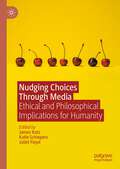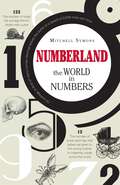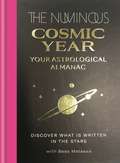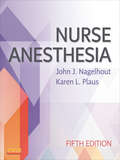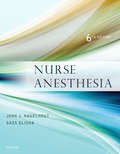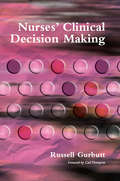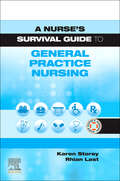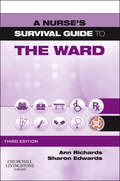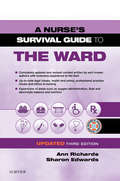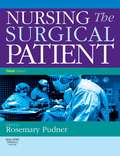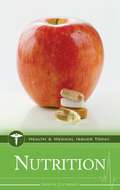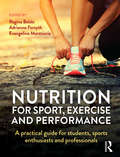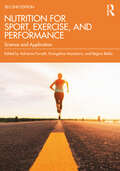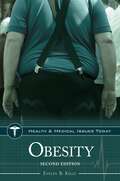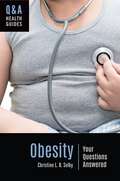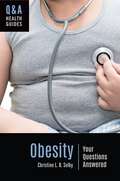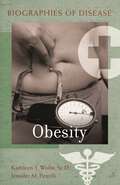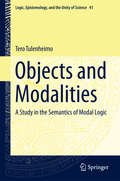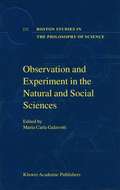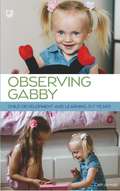- Table View
- List View
Nudging Choices Through Media: Ethical and philosophical implications for humanity
by James Katz Katie Schiepers Juliet FloydThis book addresses the growing use of computerized systems to influence people’s decisions without their awareness, a significant but underappreciated sea-change in the way the world works. To assess these systems, this volume’s contributors explore the philosophical and ethical dimensions of algorithms that guide people’s behavior by nudging them toward choices preferred by systems architects. Particularly in an era of heightened awareness of bias and discrimination, these systems raise profound concerns about the morality of such activities. This volume brings together a diverse array of thinkers to critically examine these nudging systems. Not only are high-level perspectives presented, but so too are of those who use them on a day-to-day basis. While algorithmic nudging can produce benefits for users there are also many less-obvious costs to using such systems, costs that require examination and deliberation. This book is a major step towards delineating these concerns and suggesting ways to provide a sounder basis for future policies for algorithms. It should be of interest to system designers, public policymakers, scholars, and those who wonder more deeply about the nudges they receive from various websites and on their phones.
Numberland: The World in Numbers
by Mitchell SymonsThe world is full of fascinating facts and statistics, but presented without context and in no particular order they can be overwhelming. Numberland: The World in Numbers interprets the world around us through numbers, breaking the most amazing and revealing of facts down to their bare bones. For example, did you know that the average eyelash lasts five months? That 400 quarter-pound hamburgers can be made out of one cow? Or that the average human will grow 590 miles of hair in their lifetime?Ordered in easily digestible sections such as 'Around the World', 'the USA', 'Money', 'Religion' and 'History', the book navigates an ordered path through a noisy world of information overload.
The Numinous Cosmic Year: Your astrological almanac
by The Numinous Bess MatassaYour total guide to the astrology of 2022, The Numinous Cosmic Year is part astro planner, part cosmic almanac. A guide to both the shifting astrological currents and the influence of the celestial bodies on our daily lives, this interactive monthly planner will unlock the language of astrology and help you map your path forwards and within.As well as a complete astrological overview of what's in store for 2022 and detailed instructions for how to use the book, discover what each month has in store for your sun sign, the key astrological dates for each month, which elements to work with, and journal prompts to ignite your inner journey. Flow with the waxing and waning of the moon, get ahead of each planet's retrograde phase, and plan your year in accordance with the movements of the stars.
Nurse Anesthesia - E-Book
by John J. Nagelhout Sass Elisha Karen PlausTake your understanding to a whole new level with Pageburst digital books on VitalSource! Easy-to-use, interactive features let you make highlights, share notes, run instant topic searches, and so much more. Best of all, with Pageburst, you get flexible online, offline, and mobile access to all your digital books. Written specifically for nurse anesthetists, Nurse Anesthesia, 5th Edition provides comprehensive coverage of both scientific principles and evidence-based practice. It offers a complete overview of anatomy, physiology, pharmacology, and pathophysiology, and offers practical coverage of equipment and anesthesia management. This edition includes updated information on pharmacokinetics, clinical monitoring, drug delivery systems, and complications, and revises chapters on airway management and anesthesia for cardiac surgery. Written by leading nurse anesthesia experts John Nagelhout and Karen Plaus, this perennial bestseller prepares anesthesia students and CRNAs for today's clinical anesthesia practice. Over 650 figures of anatomy, nurse anesthesia procedures, and equipment depict complex concepts and information. An easy-to-use organization covers basic principles first, and builds on those with individual chapters for each surgical specialty. UPDATED references make it quick and simple to find the latest and most important research in the field.Over 700 tables and boxes highlight the most essential information in a quick, easy-to-reference format. Expert CRNA authors provide the current clinical information you’ll use in daily practice. UPDATED pharmacology information includes pharmacokinetics, drug delivery systems, opiate antagonists, and key induction drugs. Over 100 NEW photos and illustrations enhance your understanding of difficult anesthesia concepts.UPDATED Airway Management and Anesthesia for Cardiac Surgery chapters are thoroughly revised.NEW coverage includes robotics, screening applications, and non-operating room best practices.
Nurse Anesthesia - E-Book: Textbook Of Clinical Anesthesia
by John J. Nagelhout Karen PlausGain a thorough understanding of nursing anesthesia with the most comprehensive text on the market. Written by leading expert, John Nagelhout, CRNA, PhD, FAAN, and new contributing author Sass Elisha, EdD, CRNA, Nurse Anesthesia, 6th Edition features both scientific principles and evidence-based material. Inside you’ll find a solid introduction to the history, education, and legal issues of nurse anesthetist, its scientific foundations, equipment and monitoring, and preoperative evaluation and preparation of the patient. This new edition includes chapters on patient centered care and cultural competence, additional drugs of interest, blood and blood component therapy, anesthesia management for patients with cardiac devices, anesthesia for robotic surgery, anesthesia for transplant surgery and organ procurement, and physiology and management of acute and chronic pain. Not only a key reference for practicing nurse anesthetists, this bestseller prepares you for certification and today's clinical anesthesia practice.New coverage includes the latest specifics of pharmacokinetics, drug delivery systems, opiate antagonists, and key induction drugs.Updated information on patient safety, monitoring, and pharmacology.Unique! Expert CRNA authors provide the current clinical information that you will use in daily practice. Over 700 tables and boxes highlight the most essential information in a quick, easy-to-reference format. Easy-to-use organization covers basic principles first, and builds on those with individual chapters for each surgical specialty.Updated TJC standards for monitoring and administering moderate sedation/analgesia. NEW! Expanded content includes; non-OR anesthesia, acute and chronic pain management, anesthesia implications of complementary and alternative medicine, robotic surgery, new and less invasive procedures in interventional radiography, implications of modern implanted cardiac devices, and more!NEW! Full-color design and figures clarify difficult concepts and give the text a contemporary look and feel.NEW! Co-author Sass Elisha brings a fresh perspective to this edition.
Nurses' Clinical Decision Making
by Russell GurbuttThis work includes a foreword by Carl Thompson, Senior Research Fellow, Department of Health Sciences, University of York. This inspiring text offers guidance and innovative ideas for teaching and learning. It explains how nurses make clinical decisions through the development of narratives, and how, using narratives, nurses gain a far more intimate knowledge of the patient than doctors can. The book considers service delivery around patients, renegotiation of professional roles of medical staff and their boundaries of responsibility and authority. "Nurses' Clinical Decision Making" will appeal to all undergraduate and postgraduate students of nursing, registered nurses and nurse managers. Nurse educators, hospital managers, doctors and healthcare risk managers will also find the information contained here invaluable. 'If nurses are decision-makers how can their role and practice be explained? Can decision-making be taught and are there different levels of decision-making skill? If so, how can expert decision-makers be recognised? These are just some of the pertinent questions that need to be asked if we are to recognise and understand the centrality of clinical decision-making in nursing practice. Clinical work is complex and takes place in a complex environment that centres around individuals who themselves are physically, socially and spiritually complex. Clinical work also involves multiple participants (nurses, doctors, patients, physiotherapists, occupational therapists, pharmacists to name a few) who in the course of a days work can make scores of decisions.' - Russell Gurbutt, in the Preface.
Nurses' Clinical Decision Making
by Russell GurbuttThis work includes a foreword by Carl Thompson, Senior Research Fellow, Department of Health Sciences, University of York. This inspiring text offers guidance and innovative ideas for teaching and learning. It explains how nurses make clinical decisions through the development of narratives, and how, using narratives, nurses gain a far more intimate knowledge of the patient than doctors can. The book considers service delivery around patients, renegotiation of professional roles of medical staff and their boundaries of responsibility and authority. "Nurses' Clinical Decision Making" will appeal to all undergraduate and postgraduate students of nursing, registered nurses and nurse managers. Nurse educators, hospital managers, doctors and healthcare risk managers will also find the information contained here invaluable. 'If nurses are decision-makers how can their role and practice be explained? Can decision-making be taught and are there different levels of decision-making skill? If so, how can expert decision-makers be recognised? These are just some of the pertinent questions that need to be asked if we are to recognise and understand the centrality of clinical decision-making in nursing practice. Clinical work is complex and takes place in a complex environment that centres around individuals who themselves are physically, socially and spiritually complex. Clinical work also involves multiple participants (nurses, doctors, patients, physiotherapists, occupational therapists, pharmacists to name a few) who in the course of a days work can make scores of decisions.' - Russell Gurbutt, in the Preface.
A Nurse's Survival Guide to General Practice Nursing E-Book
by Karen Storey Julia Rhianedd LastHandy format makes for easy reference Clear, bulleted content puts the emphasis on quick reference Reflective activities Diagrams clearly explain difficult concepts Case studies highlight best practice
A Nurse's Survival Guide to the Ward - E-Book (A Nurse's Survival Guide)
by Sharon L. Edwards Ann RichardsThe new edition of this highly popular book is an indispensable guide to daily procedures and problems for nurses starting work on the ward or returning to practice. It provides guidance in a variety of areas including: how to organise your job and yourself; how to assess patients; clinical information on a wide range of conditions; important principles, procedures and investigations; how to administer drugs safely; and what to do in an emergency. As well as information on how to do the job, the importance of communication and nursing care issues is emphasised. Background information is also given on underlying legal, health and safety issues.This book will help you with Organising your job and yourself Assessing patients Getting clinical information on a wide range of conditions Important principles, procedures and investigations Administering drugs safely What to do in an emergency Communication, legal health and safety issues A new section on professional practice relates current issues to nursing practice Updated drug section provides essential understanding of common drug classes New resuscitation guidelines
A Nurse's Survival Guide to the Ward - Updated Edition E-Book (A Nurse's Survival Guide)
by Ann Richards Sharon L. EdwardsFurther to the success of the previous editions, A Nurse's Survival Guide to the Ward continues to be the indispensable guide to all the procedures and problems faced by nurses and healthcare professionals every day. Whether you are a clinical practicing student or a qualified nurse, this book is the perfect straightforward reference for every doubt you might have about emergency situations, as well as assessments, clinical procedures and much more.What will you find in this updated edition: Completely updated and revised content written by well-known authors with extensive experience in the field; Up-to-date legal issues, health and safety, professional practice issues and ethics in nursing; Expansions of areas such as oxygen administration, fluid and electrolyte balance and nutrition Completely updated and revised content written by well-known authors with extensive experience in the field; Up-to-date legal issues, health and safety, professional practice issues and ethics in nursing; Expansions of areas such as oxygen administration, fluid and electrolyte balance and nutrition
Nursing the Surgical Patient
by Rosemary PudnerThe new edition of this highly successful text brings it fully up to date with recent developments in surgical nursing, and includes a new chapter on perioperative stress and anxiety . The need for surgical nurses to remain at the cutting edge in relation to their knowledge and skills has never been greater, as the demands of higher patient throughput and reduced hospital stays take their toll.Nursing the Surgical Patient is written for, and by, nurses. It adopts a patient-centred approach to the care of people requiring a wide variety of surgical procedures. Compiled by experienced practitioners and educators in the field, it covers relevant anatomy and physiology, investigations, brief information on relevant medical conditions leading to surgery, an outline of the surgical procedures and the nursing care the patient will require.The key nursing care issues are described and explored, with case studies and care plans to bring theory to life. Comprehensive and research-based, yet accessible and engaging, Nursing the Surgical Patients a vital companion to nurses caring for surgical patients in either the primary or secondary care setting.This title is directed primarily towards health care professionals outside of the United States.
Nutrition (Health and Medical Issues Today)
by Sharon K. ZoumbarisNutrition addresses the most hotly debated topics in the news today: obesity, food safety, irradiation, and vegetarianism and also describes the currently accepted principles of good nutrition for men, women, and children.Despite the abundance of advice on food and diet, more Americans are obese than ever before, diabetes rates are skyrocketing, and more foods are recalled due to contamination. It is high-time for non-biased answers to the question of what is healthy and safe to eat. Nutrition provides those answers. The book explains basic guidelines for healthy eating, along with the government's role in nutrition. It examines the issues of food safety and technology and the debates about genetically modified foods, organic foods, and vegetarian dining. Food bans, such as those on transfats are discussed, as are vitamins and supplements. After tracing the history of the study of nutrition and identifying principal researchers, the book examines seven major controversies in nutrition today. This basic guide to healthy eating will give both students and adults the tools they need to choose a diet that is healthy and safe.
Nutrition for Sport, Exercise and Performance: A practical guide for students, sports enthusiasts and professionals
by Regina Belski Adrienne Forsyth Evangeline MantziorisNutrition before, during and after training or a sporting event can improve the comfort, energy and performance of athletes of all levels, from elite to recreational, as well as providing long-term health benefits. Nutrition for Sport, Exercise and Performance offers a clear, practical and accessible guide to the fundamentals of sport and exercise nutrition. The expert authors begin by explaining key principles, including understanding energy systems, exercise physiology and metabolism. They cover the basics of digestion, absorption and nutrition; examine the key macronutrients and micronutrients essential for performance; and discuss the process of dietary assessment. Part 2 goes on to explore in detail nutrition for pre- and post-training, hydration, the use of supplements and body composition, and provides guidance on developing plans for both individual athletes and teams. The final component examines specific nutrition issues and special needs, including working with elite athletes, strength-and-power athletes, young, older and disabled athletes, endurance sports, GI disturbances and rehabilitation issues. Cultural issues are also explored, including diets for vegan and vegetarian athletes, and religious perspectives and requirements. Featuring contributions from a range of sport and exercise nutrition professionals and including practical diet plans, diagrams and the latest research and evidence throughout, this is a core reference for undergraduates, nutritionists and trainers.
Nutrition for Sport, Exercise and Performance: A practical guide for students, sports enthusiasts and professionals
by Regina Belski Adrienne Forsyth Evangeline MantziorisNutrition before, during and after training or a sporting event can improve the comfort, energy and performance of athletes of all levels, from elite to recreational, as well as providing long-term health benefits. Nutrition for Sport, Exercise and Performance offers a clear, practical and accessible guide to the fundamentals of sport and exercise nutrition. The expert authors begin by explaining key principles, including understanding energy systems, exercise physiology and metabolism. They cover the basics of digestion, absorption and nutrition; examine the key macronutrients and micronutrients essential for performance; and discuss the process of dietary assessment. Part 2 goes on to explore in detail nutrition for pre- and post-training, hydration, the use of supplements and body composition, and provides guidance on developing plans for both individual athletes and teams. The final component examines specific nutrition issues and special needs, including working with elite athletes, strength-and-power athletes, young, older and disabled athletes, endurance sports, GI disturbances and rehabilitation issues. Cultural issues are also explored, including diets for vegan and vegetarian athletes, and religious perspectives and requirements. Featuring contributions from a range of sport and exercise nutrition professionals and including practical diet plans, diagrams and the latest research and evidence throughout, this is a core reference for undergraduates, nutritionists and trainers.
Nutrition for Sport, Exercise, and Performance: Science and Application
by Adrienne Forsyth Evangeline Mantzioris Regina BelskiNutrition for Sport, Exercise, and Performance offers a clear, practical, and accessible guide to building a comprehensive understanding of sport and exercise nutrition from leading experts in nutrition and exercise science. Nutrition before, during, and after training or a sporting event can improve the comfort, energy, and performance of athletes of all levels, from elite to recreational, as well as providing long-term health benefits. As such, nutrition is a key element of an athlete’s health and performance strategy, whether competing recreationally or at an elite level.Split into three parts, this new and revised edition of Nutrition for Sport, Exercise, and Performance provides an evidence-based introduction to nutrition for sport, exercise, and performance. Part I focusses on nutrition and sport science by explaining key principles underpinning sports nutrition science, including energy systems, exercise physiology and metabolism, and the digestion and absorption of macronutrients and micronutrients essential for performance and discusses factors influencing dietary intake, energy availability, and the process of dietary assessment. Part II is focussed on nutrition for exercise, pre- and post-training, hydration, supplements, and body composition measurement and modification. The final part (Part III) focusses on applied sports nutrition for a range of sports and athletes. This second edition delivers new insights into working with female athletes, occupational athletes, and athletes in contemporary sports including sport climbing, surfing, skateboarding, and breaking.Featuring contributions from a range of sport and exercise nutrition professionals with practical sports nutrition strategies and the latest evidence and practice guidelines, this is a core reference for undergraduate students, sports professionals, and aspiring athletes alike.
Nutrition for Sport, Exercise, and Performance: Science and Application
Nutrition for Sport, Exercise, and Performance offers a clear, practical, and accessible guide to building a comprehensive understanding of sport and exercise nutrition from leading experts in nutrition and exercise science. Nutrition before, during, and after training or a sporting event can improve the comfort, energy, and performance of athletes of all levels, from elite to recreational, as well as providing long-term health benefits. As such, nutrition is a key element of an athlete’s health and performance strategy, whether competing recreationally or at an elite level.Split into three parts, this new and revised edition of Nutrition for Sport, Exercise, and Performance provides an evidence-based introduction to nutrition for sport, exercise, and performance. Part I focusses on nutrition and sport science by explaining key principles underpinning sports nutrition science, including energy systems, exercise physiology and metabolism, and the digestion and absorption of macronutrients and micronutrients essential for performance and discusses factors influencing dietary intake, energy availability, and the process of dietary assessment. Part II is focussed on nutrition for exercise, pre- and post-training, hydration, supplements, and body composition measurement and modification. The final part (Part III) focusses on applied sports nutrition for a range of sports and athletes. This second edition delivers new insights into working with female athletes, occupational athletes, and athletes in contemporary sports including sport climbing, surfing, skateboarding, and breaking.Featuring contributions from a range of sport and exercise nutrition professionals with practical sports nutrition strategies and the latest evidence and practice guidelines, this is a core reference for undergraduate students, sports professionals, and aspiring athletes alike.
Obesity (Health and Medical Issues Today)
by Evelyn B. KellyThis book explores what obesity is, its causes and implications for health, and the many issues and controversies surrounding it, both in the medical community and within society as a whole.Obesity is defined as the state of having a body mass index (BMI) greater than 30. Although it may be easy to identify what obesity is, however, identifying its causes and effects can be more challenging. Genetic, hormonal, environmental, and behavioral factors all play a role in defining our weight, and the consequences of obesity go far beyond medical complications, to include impacts on psychological well-being and social health, and how we think about and address this growing epidemic has become just as controversial as it is important.This second edition of Obesity offers a wealth of new information and features. Coverage of genetic and hormonal causes of obesity has been greatly expanded, as has discussion of medications and surgical techniques to manage obesity. The book reflects our expanded scientific understanding of obesity and delves into medical and societal debates about weight that have emerged in recent years. Also new in this edition is a collection of case studies, each of which helps to make the topics discussed in the book more accessible to readers.
Obesity (Health and Medical Issues Today)
by Evelyn B. KellyThis book explores what obesity is, its causes and implications for health, and the many issues and controversies surrounding it, both in the medical community and within society as a whole.Obesity is defined as the state of having a body mass index (BMI) greater than 30. Although it may be easy to identify what obesity is, however, identifying its causes and effects can be more challenging. Genetic, hormonal, environmental, and behavioral factors all play a role in defining our weight, and the consequences of obesity go far beyond medical complications, to include impacts on psychological well-being and social health, and how we think about and address this growing epidemic has become just as controversial as it is important.This second edition of Obesity offers a wealth of new information and features. Coverage of genetic and hormonal causes of obesity has been greatly expanded, as has discussion of medications and surgical techniques to manage obesity. The book reflects our expanded scientific understanding of obesity and delves into medical and societal debates about weight that have emerged in recent years. Also new in this edition is a collection of case studies, each of which helps to make the topics discussed in the book more accessible to readers.
Obesity: Your Questions Answered (Q&A Health Guides)
by Christine L. SelbyThis book serves as an accessible resource for teens who want to learn more about obesity. The information and guidance it offers make it a valuable tool for young adult readers with questions or concerns about their weight.Obesity—represented by a BMI over 30—may be easy to define, but its causes and consequences and how individuals and agencies should address it are not as clear. Is obesity simply the result of eating more calories than one burns, or are other factors involved? Can an individual be obese and healthy? How does obesity affect psychological and social health? Are public health campaigns targeted at reducing obesity helping or hurting? Obesity: Your Questions Answered, a part of Greenwood's Q&A Health Guides series, answers these and other questions related to this high-interest topic. Each book in this series follows a reader-friendly question-and-answer format that anticipates readers' needs and concerns. Prevalent myths and misconceptions are identified and dispelled, and a collection of case studies illustrates key concepts and issues through relatable stories and insightful recommendations. The book also includes a section on health literacy, equipping teens and young adults with practical tools and strategies for finding, evaluating, and using credible sources of health information both on and off the internet—important skills that contribute to a lifetime of healthy decision-making.
Obesity: Your Questions Answered (Q&A Health Guides)
by Christine L. SelbyThis book serves as an accessible resource for teens who want to learn more about obesity. The information and guidance it offers make it a valuable tool for young adult readers with questions or concerns about their weight.Obesity—represented by a BMI over 30—may be easy to define, but its causes and consequences and how individuals and agencies should address it are not as clear. Is obesity simply the result of eating more calories than one burns, or are other factors involved? Can an individual be obese and healthy? How does obesity affect psychological and social health? Are public health campaigns targeted at reducing obesity helping or hurting? Obesity: Your Questions Answered, a part of Greenwood's Q&A Health Guides series, answers these and other questions related to this high-interest topic. Each book in this series follows a reader-friendly question-and-answer format that anticipates readers' needs and concerns. Prevalent myths and misconceptions are identified and dispelled, and a collection of case studies illustrates key concepts and issues through relatable stories and insightful recommendations. The book also includes a section on health literacy, equipping teens and young adults with practical tools and strategies for finding, evaluating, and using credible sources of health information both on and off the internet—important skills that contribute to a lifetime of healthy decision-making.
Obesity (Biographies of Disease)
by Kathleen Y. Wolin Jennifer PetrelliAn overview written for general readers of the history, prevention, treatment, causes, and consequences of obesity.What makes obesity a disease instead of just a matter of overeating? What are the genetic and environmental factors behind it? What new breakthroughs are being developing to combat it? This concise, information-rich volume looks at these and other important questions, clearing away misconceptions about this devastating condition.Obesity explains what scientists now know about the causes and consequences of being overweight, including the latest on the links between obesity and heart disease, diabetes, some cancers, asthma, and sleep difficulties. The book pays specific attention to the problem among obese young people, who more and more are being diagnosed with chronic illnesses that used to only be seen in adults. It also reports on promising efforts to battle obesity, from medical treatments to community awareness programs.
Objects and Modalities: A Study in the Semantics of Modal Logic (Logic, Epistemology, and the Unity of Science #41)
by Tero TulenheimoThis book develops a novel generalization of possible world semantics, called ‘world line semantics’, which recognizes worlds and links between world-bound objects (world lines) as mutually independent aspects of modal semantics. Addressing a wide range of questions vital for contemporary debates in logic and philosophy of language and offering new tools for theoretical linguistics and knowledge representation, the book proposes a radically new paradigm in modal semantics. This framework is motivated philosophically, viewing a structure of world lines as a precondition of modal talk. The author provides a uniform analysis of quantification over individuals (physical objects) and objects of thought (intentional objects). The semantic account of what it means to speak of intentional objects throws new light on accounts of intentionality and singular thought in the philosophy of mind and offers novel insights into the semantics of intensional transitive verbs.
Observation and Experiment in the Natural and Social Sciences (Boston Studies in the Philosophy and History of Science #232)
by Maria Carla GalavottiThis volume is a contribution to the ongoing debate on the distinction between a ‘context of justification’ and a ‘context of discovery’. It is meant for researchers and advanced students in philosophy of science, and for natural and social scientists interested in foundational topics. Spanning a wide range of disciplines, it combines the viewpoint of philosophers and scientists and casts a new interdisciplinary perspective on the problem of observation and experimentation.
Observing Gabby: Child Development and Learning, 0-7 Years
by Cath ArnoldThis carefully structured text will be helpful for anyone teaching or studying child development particularly with the addition of video materials to view alongside the book.Mary Briggs FRSA, CMathTeach, APECS, SFHEA, FCCT, Principal Lecturer and Programme Lead for Childhood and Education (ECS and Ed Studies), Oxford Brookes University, UKThis rich account of Gabby’s early childhood development takes the reader on an inspiring journey.Shirley Allen, School of Health and Education, Middlesex UniversityI would heartily recommend this book to any early years practitioner, who wants to better understand child development, improve the quality of their child observations and to develop their skill in linking the two seamlessly.Andrea Layzell, Project Lead and Tutor, Bradford Birth to 19 Teaching School AllianceThis book is about Gabby, an inquisitive girl who leads her own learning very effectively with support from the adults in her life. The author, her grandmother, draws on seven years of data from diaries, photos and Gabby’s own writing to consider her development and learning when cared for by both her parents and grandparents. Gabby builds on her experiences with her Latvian mother, English father and her elder sister as she faces and deals with transitions as she grows up.The chapters are presented in a chronological order as a ‘running record’ going from 0-1 year right through to 6-7 years and can be analysed through a range of theories and frameworks. With chapters considering theory and the data separately the reader can reach their own conclusions on child development before exploring the author’s analyses. Each chapter also considers the relevance of Ofsted’s Intent, Implementation and Impact framework and other theories and schemas.This book about one child's early development and learning is a fascinating insight into how young children learn for those studying or working in the early years field. It includes access to an online learning centre of video clips to bring the descriptions to life and provide further insight into Gabby’s development.Dr Cath Arnold has worked in the field of Early Childhood for over 40 years, as a practitioner/teacher, researcher, lecturer and author. Her particular interests include child study; schemas and parental involvement. This is her fifth book focussing on close observation of the spontaneous actions of young children.
